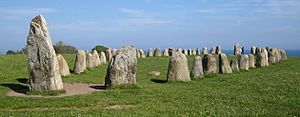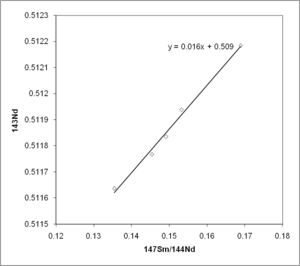Radiometric dating facts for kids
Radiometric dating is a cool way to figure out how old things are. It's also called radioactive dating. This method looks at tiny amounts of natural radioactive stuff, called isotopes, inside a sample. It then checks how much of that radioactive stuff has changed into other elements over time.
Scientists know exactly how fast these changes happen. This helps them find the age of rocks, fossils, and even old artifacts made by humans. It's the main way we learn about the age of the Earth and create the geological time scale. Some common types of radiometric dating are radiocarbon dating, potassium-argon dating, and uranium-lead dating.
Contents
How Radioactive Elements Help Us Date Things
Everything around us is made of tiny building blocks called chemical elements. Each element has a special number of protons in its center, called the atomic nucleus. Elements can also come in different versions called isotopes. These isotopes have the same number of protons but different numbers of neutrons.
Some isotopes are naturally unstable. This means they don't stay the same forever. Over time, an atom of an unstable isotope will naturally change into a different, more stable isotope. This process is called radioactive decay. It happens when the atom gives off tiny particles like electrons or alpha particles, or splits apart.
The Age Clock
When an unstable "parent" isotope decays, it turns into a stable "daughter" isotope. This happens at a very steady rate, like a super-accurate clock. Scientists measure how much of the parent isotope is left and how much of the daughter isotope has formed in a sample.
By knowing the decay rate of the parent isotope, they can calculate how long it took for that amount of decay to happen. This gives them the age of the sample. It's like knowing how fast sand falls in an hourglass and then measuring how much sand is in the bottom to know how much time has passed.
The decay rate is often described by something called half-life. This is the time it takes for half of the parent isotope atoms in a sample to decay into daughter isotopes. Each radioactive isotope has its own unique half-life, which can range from seconds to billions of years.
Making Sure the Dates Are Right
For radiometric dating to work perfectly, a few things need to be true:
- No Cheating: The parent or daughter isotopes should not have entered or left the material after it first formed. If extra isotopes got in, or some escaped, the age calculation would be wrong.
- Checking for Changes: Scientists need to be careful about anything that might have changed the amounts of the isotopes. For example, if a rock was heated or squeezed a lot, it could affect the results.
To get the most accurate age, scientists often take samples from different parts of a rock. They might also use different dating methods on the same sample. For example, a study on some very old rocks from Greenland used five different dating methods. All the methods agreed on an age of about 3.64 billion years, with only a small difference of 30 million years. This shows how reliable the methods can be when used carefully.
Related pages
Images for kids
-
A concordia diagram used in uranium–lead dating. This shows how scientists can find the correct age even if some lead isotopes were lost.
-
Apatite crystals are often used in fission track dating.
See also
 In Spanish: Datación radiométrica para niños
In Spanish: Datación radiométrica para niños







